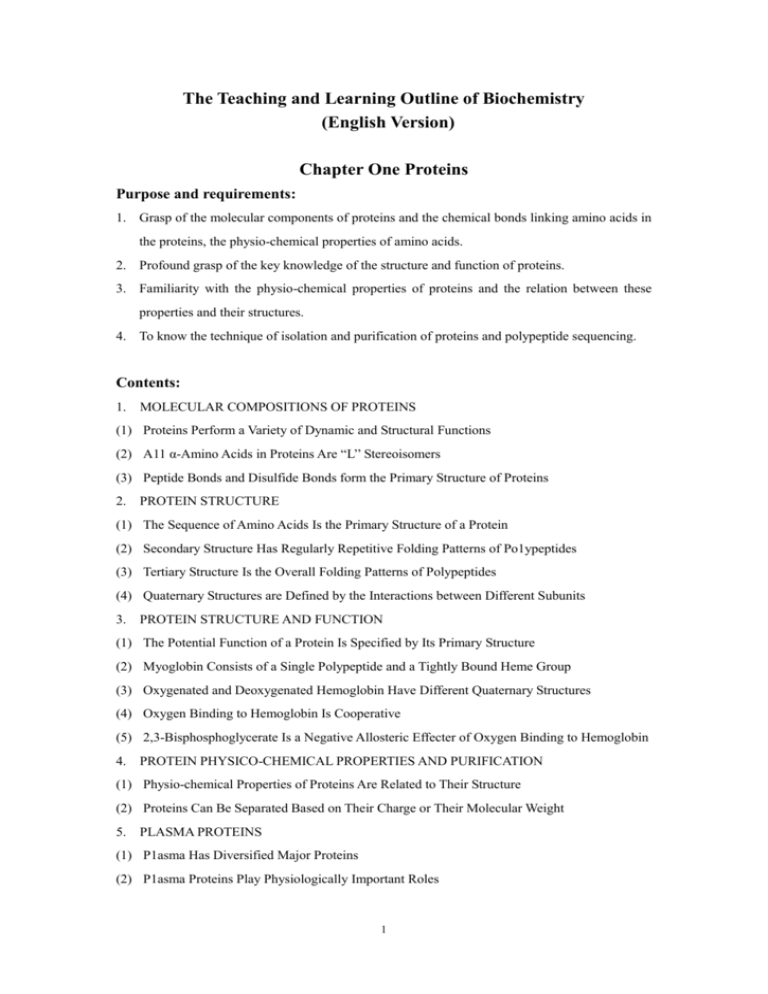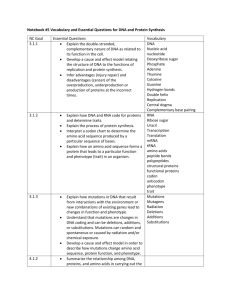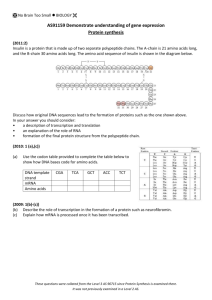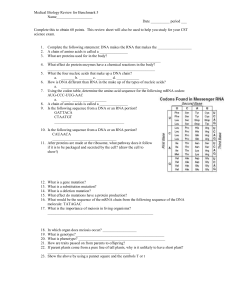The English-Chinese Bilingual Teaching and Learning Outline of
advertisement

The Teaching and Learning Outline of Biochemistry (English Version) Chapter One Proteins Purpose and requirements: 1. Grasp of the molecular components of proteins and the chemical bonds linking amino acids in the proteins, the physio-chemical properties of amino acids. 2. Profound grasp of the key knowledge of the structure and function of proteins. 3. Familiarity with the physio-chemical properties of proteins and the relation between these properties and their structures. 4. To know the technique of isolation and purification of proteins and polypeptide sequencing. Contents: 1. MOLECULAR COMPOSITIONS OF PROTEINS (1) Proteins Perform a Variety of Dynamic and Structural Functions (2) A11 α-Amino Acids in Proteins Are “L’’ Stereoisomers (3) Peptide Bonds and Disulfide Bonds form the Primary Structure of Proteins 2. PROTEIN STRUCTURE (1) The Sequence of Amino Acids Is the Primary Structure of a Protein (2) Secondary Structure Has Regularly Repetitive Folding Patterns of Po1ypeptides (3) Tertiary Structure Is the Overall Folding Patterns of Polypeptides (4) Quaternary Structures are Defined by the Interactions between Different Subunits 3. PROTEIN STRUCTURE AND FUNCTION (1) The Potential Function of a Protein Is Specified by Its Primary Structure (2) Myoglobin Consists of a Single Polypeptide and a Tightly Bound Heme Group (3) Oxygenated and Deoxygenated Hemoglobin Have Different Quaternary Structures (4) Oxygen Binding to Hemoglobin Is Cooperative (5) 2,3-Bisphosphoglycerate Is a Negative Allosteric Effecter of Oxygen Binding to Hemoglobin 4. PROTEIN PHYSICO-CHEMICAL PROPERTIES AND PURIFICATION (1) Physio-chemical Properties of Proteins Are Related to Their Structure (2) Proteins Can Be Separated Based on Their Charge or Their Molecular Weight 5. PLASMA PROTEINS (1) P1asma Has Diversified Major Proteins (2) P1asma Proteins Play Physiologically Important Roles 1 Chapter Two Nucleotide and Nucleic acids Purpose and requirements: 1. Grasp of the nucleotide structure, including the components of the nucleotide and the chemical bonds linking the components, and the names and abbreviations of bases, nucleosides and nucleotides. 2. Profound grasp of the key knowledge of the structure and function of DNA and RNA. 3. Familiarity with the physio-chemical properties of DNA and the relation between these properties and the DNA structure. 4. To know the technique of isolation and purification of nucleic acids and DNA sequencing. Contents: 1. NUCLEOTIDES AND POLYNUCLEOTIDES (1) Nucleotide is Composed of Base,Pentose,and Phosphoryl Group (2) Nucleotides Have Different Derivatives (3) Polynucleotide Is Formed When Many Nucleotide Sequence Are Linked Together (4) The Primary Structure of Polynucleotides Is the Nucleotide Sequence 2. STRUCTURES AND FUNCTIONS OF DNA (1) DNA is a Double Helix (2) The Native DNA Is Supercoiled and Has a Highly Organized Structure (3) DNA Can Be Replicated and Transcribed 3. STRUCTURS AND FUNCTIONS OF RNA (1) Messenger RNA Serves as the Template for Protein Synthesis (2) Transfer RNA Is the Amino Acid Carrier for Protein Synthesis (3) Ribosomal RNA Assembles a Machinery for Protein Synthesis (4) Some Small RNAs Are Non-coding RNAs 4. PHYSICO-CHEMICAL PROPERTIES OF NUCLEIC ACIDS (1) Nucleic Acids Have Strong UV Absorption (2) Double—Stranded DNA Can Be Denatured and Renatured (3) Nucleic Acids from Different Resources Can Be Hybridized 2 Chapter Three Enzymes Purpose and requirements: 1. Grasp of definitions of enzyme and coenzyme, essential groups and catalytic groups of active center, E-S complex, zymogen, Km, Vmax. 2. Familiarity with enzyme specificities, effects of pH and temperature on rates of enzymatic reactions, differences of competitive inhibition, noncompetitive inhibition, uncompetitive inhibitions, and allosteric regulatory of enzyme. 3. To know the mechanism of enzymatic reactions, determination of Km and Vm, nomenclature and classification of enzymes, the relationship between enzymes and diseases, and the application of the relationship in medicine. Contents: 1. OVERVIEW (1) Enzymes Are Biomolecules with Catalytic Activities (2) The Active Site of an Enzyme Is a Region for Catalyzing the Reaction (3) Isoenzymes Are in Most Cases Encoded by Different Genes (4) Enzymes Are both Potent and Selective (5) Many Mechanisms Drive the Enzymatic Catalysis (6) Enzymes Are Classified and Named According to Their Reaction Type 2. ENZYME KINETICS (1) Substrate Concentration Affects the Rate of Enzymatic Reactions (2) Vmax Can Be Affected by Varying Enzyme Concentrations (3) Enzyme Activity Is Temperature Dependent (4) Enzyme Activity Is Depends on pH (5) Enzymes Can Be inhibited by Specific Substances 3. REGULATION OF ENZYMES (1) Allosteric Enzymes Can Be Regulated by Altering Their Conformations (2) Enzyme activities Can Be Regulated by Chemical Modification (3) Many Enzymes Are Released as inactive Precursors 4. MEDICAL ASPECTS OF ENZYMES (1) Deficiency of Abnormality Of Enzymes Can Cause Disorders (2) Serum Enzymes Are Used for the Diagnosis of Many Diseases (3) Enzymes Are Used as Chemical Reagents in Clinical Analyzers 3 Chapter Four Carbohydrate Metabolism Purpose and requirements: 1. To know the physiological functions of the sugar, sugar digestion and absorption process and the energy supply forms. 2. To understand the process of sugar anaerobic glycolysis and aerobic oxidation, the key enzymes in particular steps, the main factors and the physiological significance of regulation. 3. Grasp of definitions, process and physiological significance of tricarboxylic acid cycle. 4. To know pentose phosphate pathway and its key enzymes as well as its physiological significance. 5. Familiarity with synthesis and degradation of glycogen, gluconeogenic pathways and their key enzymes. 6. To know the regulation of blood glucose levels and causes of abnormal blood glucose levels. Contents: 1. OVERVIEW (1) Cells Have Choice among Alternative Substrate, but Glucose Is More Important for Their Needs (2) G1ucose is the Principa1Transported Carbohydrate in Humans (3) Glucose Uptake into the Cells is Regulated (4) Glucose Oxidation Can Proceed in Many Different Pathways 2. GLYCOLYSIS (1) G1ycolytic Pathway Begins with ATP-Dependent Phosphorylations (2) Most Glycolytic intermediates Have Three Carbons (3) Phosphofructokinase is the Most Important Regulatory Enzyme in Glycolysis 3. FATES OF PYRUVATE (1) Lactate is Produced from Pyruvate Under Anaerobic Conditions (2) Pyruvate is Completely Oxidized to CO2 and H2O in the Mitochondrion (3) Acetyl-CoA Can Be Used for the Synthesis of Fatty Acids,Cho1esterol,and Ketone Bodies 4. GLUCONEOGENESIS (1) Three Irreversible Reactions G1yco1ysis Must Be Bypassed in Gluconeogenesis (2) Fatty Acids Cannot Be Convened into Glucose (3) G1ycolysis and Ghconeogenesis Are Regulated by Hormones and Allosteric Effectors (4) Glyconeogenesis Is Physiologically Important 5. PENTOSE PHOSPHATE PATHWAY 4 (1) The Pentose Phosphate Pathway Can Be Divided Oxidative Branch and Non-oxidative Branch (2) G1ucose-6-phosphate Dehydrogenase Reaction is the Irreversible and Committed Step (3) The Pentose Phosphate Pathway Provides Specialized Products for Biosynthesis of Other Important Molecules 6. GLYCOGEN METABOLISM (1) Carbohydrates Are Stored as Glycogen (2) G1ycogen Is Readily Synthesized From Glucose (3) G1ycogen Is Degraded by Phosphorolytic Cleavage (4) G1ycogen Metabolism Is Regulated by Hormones and Metabolites (5) G1ycogen Accumulates in Several Enzyme Deficiencies 7. BLOOD SUGAR (1) An Adequate Blood Glucose Level Must Be Maintained at All Times (2) Metabo1ic and Hormonal Mechanisms Regulate the Concentration of the Blood Glucose 5 Chapter Five Lipid Metabolism Purpose and requirements: 1. To know digestion and absorption process of lipids and familiar with the process of fat mobilization and the rate-limiting enzyme. 2. Grasp of β-oxidation of fatty acids and regulate factors. Understand other degradation ways of fatty acids. Grasp of the definitions, the physiological significances, generating process and enzymes of ketone bodies. Be familiar with the regulation of ketone bodies generation. 3. Grasp of the raw materials, enzymes, key steps of fatty acid synthesis. Be familiar with the process including the elongation of longer carbon chain fatty acids, and the basic process of triglyceride synthesis. 4. Familiarity with the specific classes of phosphoglycerides lipids and their metabolism. 5. To understand the structure of cholesterol, distribution, physiological functions, familiar with raw materials, the key enzyme and key steps of cholesterol synthesis and its regulation. 6. Grasp of the classification, properties and functions of plasma lipoproteins, familiar with their metabolism. Contents: 1. OVERVIEW (1) Lipids Are Water-Insoluble Organic Compounds Essentia1 for Living Organisms (2) Digestion of Dietary Lipids Requires Bile Salts and Pancreatic Enzymes (3) Digested Products of Lipids Are Assembled in Intestinal Mucosa Cells 2. TRIGLYCERIDE METABOLISM (1) Mobilization of Stored Triglycerides in Adipose Tissue Is Catalyzed by Hormone Sensitive Lipase (2) Fatty acids Are Oxidazed Acetyl-CoA, NADH, and FADH2 by β- Oxidation (3) The Liver Converts Excess Fatty Acids to Ketone Bodies (4) G1ycerol May Enter Cellular Glyco1ysis or Gluconeogenesis for Metabolism (5) Fatty Acids Are Synthesized from Acetyl CoA (6) Arachidonic acid Is Converted to Biologically Active Derivatives 3. PHOSPHOLIPID METABOLISM (1) Phosphoglycerides Are Synthesized via de novo and Salvage Pathways and Degraded by Phospholipases (2) Sphingolipids Are Synthesized from Sphingosine and Degraded in the Lysosome 4. CHOLESTEROL METABOLISM 6 (1) Cho1esterol is Synthesized from Acetyl CoA (2) Cho1esterol Can Be Converted to Biological Mediators But its steroid Nucleus Cannot Be Degraded in the Human Body 5. LIPID TRANSPOT IN PLASMA (1) P1asma Lipids Are Transported by and Metabolized on Lipoproteins (2) P1asma Lipids Are Abnormally Elevated in Hyperlipidemia 7 Chapter Six Biological Oxidation Purpose and requirements: 1. To know the characteristics of biological oxidation in human body. 2. Grasp of the concept of biological oxidation and its three stages. Master the sequence of mitochondrial respiratory chain and the coupling sites. 3. Familiarity with the concept of oxidative phosphorylation and its mechanism, to know the factors that affect oxidative phosphorylation. Contents: 1. OVERVIEW 2. OXIDATIVE PHOSPHORYLATION IN MITOCHONDRIA (1) The Respiratory Chain Uses Molecular Oxygen to Oxidize NADH and FADH2 (2) Phosphorylation of ADP to ATP is Coupled With Redox Reactions (3) The Efficiency of Glucose of Oxidation is Close to 40% (4) Oxidative Phosphorylation is Regulated (5) Shuttle Systems Indirectly Convey Cytosolic NADH into Mitochondria for Oxidation 3. MITOCHONDRIAL DISEASES 8 Chapter Seven Amino Acid Metabolism Purpose and requirements: 1. Understanding of the nutrition, digestion, absorption and the putrefaction of proteins in the body. 2. Grasp of the transamination and deamination reactions as well as α-keto acids metabolism in general pathway of amino acids catabolism. 3. Understanding the alanine-glucose cycle, grasp the physiological significance, the key enzymes and key steps of urea cycle and its regulation. 4. Familiarity with the specific metabolism of individual amino acids, grasp the metabolism of one carbon unit. Contents: 1. DIETARY PROTEIN NUTRITION (1) Nothing in the Cell Works Without Proteins (2) The Nitrogen Balance Indicates That the Protein Metabolic Status,and the Amino Acid Pattern in Foods Determines Its Nutrition Value 2. DIGESTION,ABSORPTION,AND PUTREFACTION (1) Dietary Proteins Are Digested by Enzymes in the digestive tract (2) Amino Acids Are Actively Absorbed in the Intestine (3) Undigested Proteins Undergo Putrefaction 3. GENERAL PATHWAYS OF AMINO ACID CATABOLISM (1) Ubiquitin Marks Cellullar Proteins for Destruction and Proteasome Degrades ubiquitinated Proteins (2) The Amino Group of Amino Acids is Released as Ammonia (3) The α-Keto Acids Can Be Oxidized to CO2 and H2O and Used for Gluconeogenesis and Ketogenesis 4. AMMONIA METABOLISM (1) Ammonia Can Be Accumulated in vivo by Several Ways (2) Nontoxic forms Ammonia Is Transported in Bloodstream (3) Urea Is Synthesized in the Urea Cycle (4) Failure of the Urea Cycle Causes Hyperammonemia and Central Nervous System Dysfunction 5. METABOLISMS OF INDIVIDUAL AMINO ACID (1) Decarboxylation of Amino Acids Generates Important Regulatory Molecules 9 (2) The Major One-Carbon Unit Sources Are Serine, G1ycine and Histidine (3) Methonine and Cysteine Are Metabolically Related (4) Defects in Aromatic Phenylalanine and Tyrosine Metabolism Are Closely Related to Genetic Diseases (5) The Degradation of Valine,Leucine,and Isoleucine Begins with Transamination and Oxidative Decarboxylation 10 Chapter Eight Nucleotide Metabolism Purpose and requirements: 1. To know digestion and absorption of nucleic acids and anabolism pathway of nucleic acids in the human body. 2. Profound grasp of the raw material of purine and pyrimidine synthesis, the end products of purine and pyrimidine breakdown. 3. Grasp of the formation of deoxynucleotide from ribonucleotide. 4. To know the function of antimetabolites. Contents: 1. BIOSYNTHESIS AND DEGRADATION OF PURINE NENUCIEOTIDES (1) Purine Nucleotides Are Synthesized through de novo and Salvage Pathways (2) Purines Are Degraded to Insoluble Uric Acid 2. BIOSYNTHESIS AND DEGRADATION OF PYRIMIDINE NUCIEOTIDES (1) Pyrimidine Nucleotides Are Synthesized de novo and Salvaged (2) Pyrimidine Nucleotides Are Degraded to Soluble Small Molecules 3. FORMATION OF DEOXYRIBONUCLEOTIDES (1) Ribonucleotide Reductase- Catalyzed by Substrates Are Ribonucleoside Diphosphates (2) Conversion of dUMP to dTMP is Catalyzed by Thymidylate Synthase 4. NUCLEOTIDE METABOLISM IN MEDICINE (1) Some Diseases Are Associated with Nucleotide Metabolism (2) Many Antineoplastic Drugs Inhibit Nucleotide Metabolism 11 Chapter Ten DNA biosynthesis Purpose and requirements: 1. Familiarity with the central dogma. 2. Grasp of DNA replication and reverse transcription. 3. To know DNA damage repair systems. Contents l. DNA-DEPENDENT DNA SYNTHESIS (REPLICATION) (1) DNA Replication Is Semi-conservative, Semi-discontinuous and Faithfull (2) DNA Polymerases Need Sets of Accessory Proteins (3) DNA is Replicated as a Single Unit in E.coli (4) DNA Replication in Eukaryotic Cells is More Complicated 2. RNA-DEPENDENT DNA SYNTHESIS (REVERSE TRANSCRIPTION) (1) Reverse Transcription is RNA—Dependent DNA Synthesis (2) Retroviruses Are Closely Linked with Clinical and Lab Researches 3. DNA DAMAGE AND REPAIR (1) DNA Damage Leads to Mutation (2) DNA Repair Rescues DNA from Damages (3) DNA Damage and Repair Are Related to Diseases 12 Chapter Eleven RNA Biosynthesis Purpose and requirements: 1. Grasp of the concept of RNA biosynthesis. 2. Grasp of the feature of transcription and post-transcriptional processing of pre-mRNA, pre-tRNA and pre-rRNA. 3. Familiarity with ribozyme and self-splicing. 4. To know RNA replicase. Contents l. DNA-DEPENDENT RNA SYNTHESIS (TRANSCRIPTION) (1) RNA Synthesis Requires RNA Polymerase and DNA Template and Activated Precursors (2) Transcription in Prokaryotes Takes Place in Three Phases (3) Transcription in Eukaryotes Is Much More Complex Than That in Prokaryotes 2. RNA POST-TRANSCRIPTIONAL PROCESSING (1) Some RNAs Are Chemically Modified after Transcriptional Processing (2) Eukaryotic mRNAs Are Extensively Processed by Nuclear Enzyme Systems (3) Ribosomal RNAs Are Processed from Larger Precursors (4) Transfer RNAs Are Extensively Processed and Modified (5) RNA Can Act as Catalysts 3. RNA-Dependent RNA Synthesis (RNA Replicahon) 13 Chapter Twelve Protein biosynthesis(Translation) Purpose and requirements: 1. Grasp of the features of the genetic code. 2. Familiarity with the structure and function of mRNA, tRNA, and rRNA. 3. Grasp the process of protein synthesis in prokaryotes. 4. Familiarity with the process of protein biosynthesis in eukaryotes. 5. To know protein folding, and clinical relatives in protein synthesis. Contents 1. PROTEIN SYNTHESIS SYSTEM (1) Genetic Code Defines the Relationship between the Base Sequence of mRNA and the Amino Acid Sequence of Polypeptide (2) tRNA Is the Adaptor Molecule in Protein Synthesis (3) Ribosomes Are the Workbenches for Protein Synthesis (4) Protein Factors Are Required in Protein Synthesis 2. PROTEIN SYNTHESIS PROCESS (1) Ribosomal Protein Synthesis Has Some Features (2) Amino Acids Are Activated by an Ester Bond with the 3’Terminus of Transfer RNA (3) The Initiation Complex Brings Ribosome, Messenger RNA,and Initiator-Transfer RNA Together (4) Polypeptides Grow Stepwise from the Amino Terminus to the Carboxyl Terminus (5) Release Factors Terminate Ribosome Cycle (6) Protein Synthesis Is Energetically Expensive 3. POSTTRANSLATIONAL PROCESSING AND TARGETING (1) Newly Synthesized Polypeptide Chains Undergo Folding (2) Newly Synthesized Polypeptide Chains Undergo Posttranslational Modification and Processing (3) During or after Post-translational Processing the Proteins Are Translocated to Its Proper Destination (4) PROTEIN SYNTHESIS IN MEDICINE (5) Molecular Diseases Are Associated With Defective Proteins (6) Protein Synthesis Can Be Inhibited by Antibiotics and Toxins 14 Chapter Thirteen Regulation of Gene Expression Purpose and requirements: 1. Grasp of transcriptional regulation in prokaryotic gene expression. 2. Familiarity with the basic concepts and principle of regulation of gene expression. 3. To know the gene transcription regulation in eukaryotic. Contents 1. GENERAL PRINCIPLES OF GENE EXPRESSION REGULATION (1) Gene Expression Is Regulated by DNA-Protein Interaction (2) Gene Expression Is Required for Cell Survival and/or Growth and Differentiation (3) Gene Expression Exhibits Temporal- and Spatial- Specificities (4) cis- Acting Elements Are Regulatory Sequences of DNA (5) trans- Acting Factors Are Protein Factors (6) Gene Expression Is Regulated by DNA-Binding Proteins 2. REGULATION OF GENE EXPRESSION IN PROKARYOTES (1) Many Prokaryotic Genes Are Clustered and Regulated in Operons (2) A Repressor Protein Regulates the Transcription of the Lac operon in Escherichia coli (3) trp Operon of Escherichia coli Is Regulated by Transcription Attenuation 3. REGULATION OF GENE EXPRESSION IN EUKARYOTES (1) The Structure of Eukaryotic Genome Is Complex (2) Regulation of Gene Expression in Eukaryotes Is Very Complex (3) Transcription by RNA Pol I and III Is Regulated at the Initiation Step (4) RNA Pol II Transcriptional Regulation Is More Complex than RNA Pol I and III 15 Chapter Seventeen DNA-Based Information Technology Purpose and requirements: 1. Grasp of concepts of recombinant DNA and recombinant DNA technology. 2. Familiarity with the basic principles of recombinant DNA technology. 3. To know the relation between recombinant DNA technology and medicine. 4. To know the conception of PCR. Contents 1. DNA CLONING (1) Restriction Endonucleases and DNA Ligase Are Important Tools for DNA Manipulation (2) Cloning Vectors Can Replicate Autonomously in a Host Cell (3) A Foreign DNA Can Be Cloned and Screened from a DNA Library (4) The Size of Restriction Fragments Is Determined by Southern Blotting 2. POLYMERASE CHAIN REACTION (1) A DNA Fragment Can Be Amplified with the Polymerase Chain Reaction (2) Polymerase Chain Reaction and Its Varieties Are Used in Laboratory and Clinical Practice 3. DNA SEQUENCING 4. DNA DIAGNOSIS OF GENETIC DISEASE (1) Allelic Heterogeneity is the Greatest Challenge for Molecular Genetic Diagnosis (2) Single-Nucleotide Polymorphisms, Restriction-Site Polymorphisms, and Variable Number of Tandem Repeats Are Used as Genetic Markers (3) Tandem Repeats Are Used for DNA Fingerprinting (4) Dot Blotting Is Used for Genetic Screening (5) DNA Microarrays Can Be Used for Genetic Screening 5. GENE THERAPY (1) Gene Therapy Targets Somatic Cells (2) Viruses Are Used as Vectors for Gene Therapy (3) Retroviruses Can Splice a Transgene into the Cell’s Genome (4) Antisense Oligonucleotides Can Block the Expression of Rogue Genes 6. TRANSGENIC AND GENE TARGETING TECHNIQUES (1) Selective Germline Mutations Can Be Produced (2) Tissue-Specific Gene Expression Can Be Engineered into Animals 16








